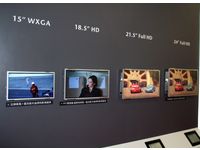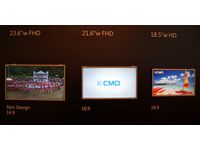16:9 Screens Popular, But Movies Go Wider
Have you ever wondered why the wide screens have invaded our living rooms and computer desks so rapidly? It’s a matter of cost. A wide screen, 16:10 display costs less to produce than a 4:3 screen since. The cost lies in the cutting stage of manufacturing where big panels, which usually measures around 2m x 1.9m, gets sliced up into smaller panels that actually go into displays.
Using wide formats a manufacturer can produce more 16:10 displays than 4:3 displays. The same logic applies to 16:9 in fact this aspect ratio yields even better results. You can get even more displays when cutting the panels in the 16:9 form factor.
The end user then should have a couple of advantages. First, the displays should be the cheaper in purchase cost for the consumer. Second, 16:9 are better to watch movies with since it’s the native format of many TV series and of many movies. Third, high definition like 720p and 1080p resolutions are produced to fit nicely in a 16:9 format, i.e. 1920x1080 pixels and not 1900 x 1200 (16:10) such as in most computer displays. With a 16:9 display, you can watch Full HD movies without the need to scale them.
However, the trend is changing again, as most movies coming out now are produced in even wider format than 16:9. So even now 16:9 displays are becoming an issue for most users who are into serious home theater setups.
The disadvantages however are similar to those that we experienced by switching from 4:3 to 16:9 screens. Smaller vertical space, smaller overall working area compared with screens with the same diagonal size. If a user was using say, a 21-inch 4:3 screen but wanted to upgrade to a 16:9 display, they would have to purchase a 23-inch or 24-inch screen to give a similar working area.
The new sizes that we will see in desktop and notebook displays more and more often will be 14", 15.6", 18.5", 21.6", 23.6". The native resolution ranging from HD (1366x768) to Full HD (1920x1080).
Get Tom's Hardware's best news and in-depth reviews, straight to your inbox.
-
KyleSTL I'm not exactly sure of the point of this article, but it's interesting, and true. Why are studios using like 16:3 aspect ratios? It's rediculous. I'm watching my movies on a 42" 1080p plasma, I can't imagine watching the same ultra-ultra-wide movie on a 4:3 CRT, YEESH!Reply -
hawler I hate the fact that now when I watch my movies on my 50" LCD I still get black bars on the top and bottom for the movies that use wider ratios than 16:9.Reply
Why don't movie companies just use 16:9? It's what all the HD resolutions are and it looks a lot better to use an entire screen than just a portion of it. NO ONE own anything but a 4:3 or 16:9 TV (or 16:10 Monitor) yet they release movies that are, i believe it is, 2.35:1 all the time.
It's really starting to annoying me -
Maxor127 I don't even notice the black bars and I kind of liked them since if they were smart making a dvd, the subtitles and closed captioning would be nicely in the bottom black bar.Reply -
garydale The point about 16:9 not needing to scale is a bit misleading. You don't need to scale 16:10 either. It's just a matter of positioning. Having a 16:10 display (1920x1200) gives you some screen space for controls, subtitles, or whatever.Reply
And yes, I don't care for the ultra-wide movies either. 4:3 or 16:9 are reasonable approximations for a human's field of vision. 2.35:1 isn't. It's been a marketing gimmick since movies first went wide to compete against TV. Time to return to reality and start making movies in a standard, human, aspect ratio. -
xsamitt I agree 100% Garydale.........I wish they would adopt a standard and just go with it.Reply
Does any one know what the conversion is 2.35.1 would be what exactly?
And when is going to for sale?i keep holding off getting a very expensive tv for the fact im not made out of money and it will have to do me for a very long time.
As far as i know tvs in the next couple of years will be like 300 lines instead of the meager 1080.......so it would make what we have now look like junk. -
I am a bit confused by this math:Reply
"If a user was using say, a 21-inch 4:3 screen but wanted to upgrade to a 16:9 display, they would have to purchase a 23-inch or 24-inch screen to give a similar working area."
To equal the same area as a 21-inch 4:3, one would need a 22.257-inch 16:9 display. So saying one would have to purchase a 24-inch is wrong.

